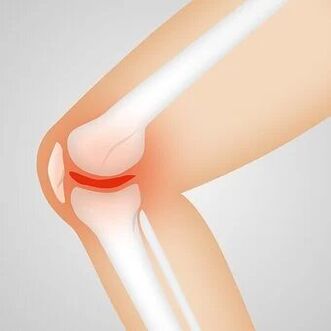Osteoarthritis is a non-inflammatory pathology joints characterized by degeneration of articular cartilage, marginal hypertrophy of bone tissue and changes in the synovial membrane. This pathology often occurs in the elderly.
joints characterized by degeneration of articular cartilage, marginal hypertrophy of bone tissue and changes in the synovial membrane. This pathology often occurs in the elderly.
Osteoarthritis and arthritis
Do not confuse osteoarthritis and arthritis. In some sources, you can see that osteoarthritis is different from arthritis in that the former is supposedly non-inflammatory and the latter is caused by inflammation. In fact, arthritis is a collective covering osteoarthritis, rheumatoid arthritis and gout (the term umbrella).
Causes of osteoarthritis
Osteoarthritis is a fairly common disease. According to some data, more than 75% of people over the age of 70 have certain symptoms of osteoarthritis. As osteoarthritis progresses with age, the disease is not caused solely by the aging of joint tissues. Joint injuries and other factors can accelerate the development of pathology. These include:
- osteoporosis;
- excess body weight;
- postmenopausal women;
- various metabolic diseases;
- endocrine diseases;
- micronutrient deficiency;
- hereditary predisposition;
- congenital pathologies of the joints (dysplasia);
- joint injury;
- regular microtrauma;
- exposure to certain toxins;
- surgical interventions in the joints, etc.
Pathology can be primary and secondary. When the cause is not identified, osteoarthritis is called primary (or idiopathic). The disease is associated with trauma, metabolic diseases, endocrine diseases, etc. If the result occurs, it is considered secondary.
Stages of osteoarthritis
There are 3 stages of this disease:
- There is no clear morphological pathology of articular tissues. Changes in the synovial membrane and the composition of synovial fluid are observed.
- Cartilage and meniscus begin to deteriorate. Osteophytes (marginal pathological growths) may form in the bone.
- It is characterized by significant deformation, pathological mobility or stiffness in the joint, as well as chronic pain (although the latter symptom is generally characteristic of the previous stage).
Localization and symptomatology of pathology
Osteoarthritis often affects the joints of the hands, including the distal interphalangeal joints, the proximal interphalangeal joints, and the metacarpal-carpal joint of the thumb. Other joints often affected by the disease include the cervical spine, lumbosacral, hip, knee, and first metatarsophalangeal joint. Osteoarthritis is less common in the ankle, wrist, elbow and shoulder (in such cases it is usually of secondary etiology). The clinical picture of the pathology generally includes the following symptoms:
- history of joint pain;
- deterioration of joint function;
- swelling.
The pain usually develops gradually, usually over years. Painful inflammation may be accompanied by partial or complete remission. The pain usually appears when the joint is in motion and decreases at rest, at least until the disease progresses to a more severe stage. Joint stiffness is often felt shortly after rest periods. It usually decreases within a few seconds or minutes of movement. Symptoms often appear in the elderly, and in people under the age of 40, osteoarthritis often continues asymptomatically.
Treatment of osteoarthritis
Conservative treatment of osteoarthritis
- rest, avoid excessive physical exertion;
- weight loss (to reduce pressure in the joints);
- physiotherapy as exercise therapy;
- assistants such as rods, elastic knee supports;
- judicious use of anti-inflammatory drugs.
Also, patients are often given spa treatment.
Surgical treatment of osteoarthritis
Knee replacement
Replacement arthroplasty
Prophylaxis
To minimize the risk of developing osteoarthritis, adequate physical activity, timely treatment of injuries, congenital and acquired abnormalities in the biomechanics of the joint (for example, straightening of the straight legs) is required. Prevention methods also include weight loss (which increases increased stress on the joints).






























